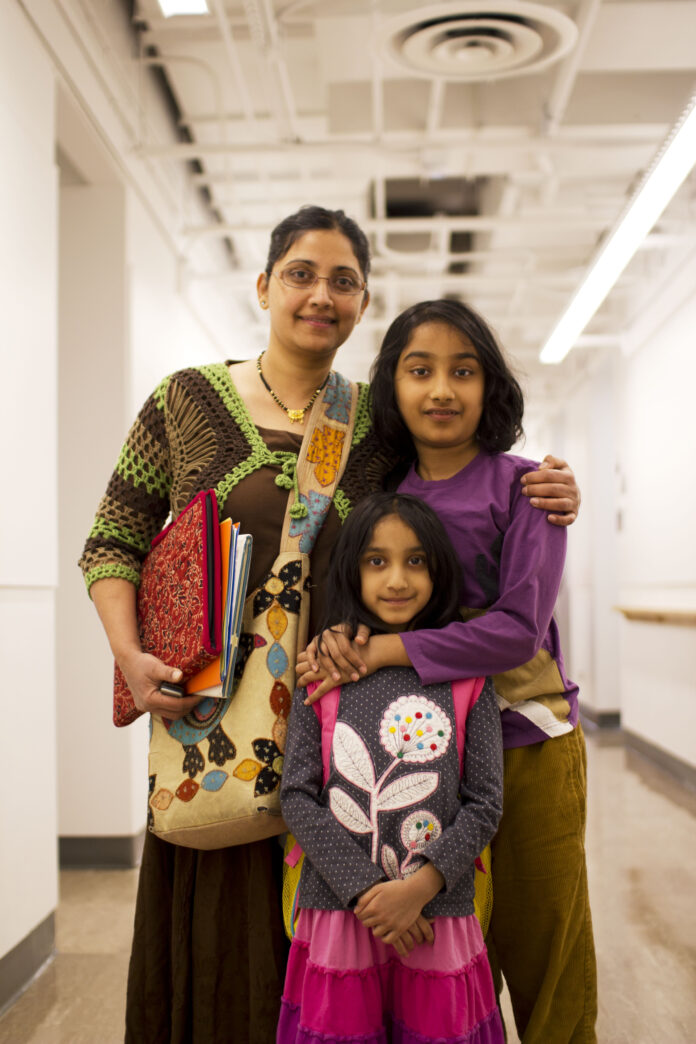Arav Karighattam is in Math 125A, an upper-division math class on real analysis. He’s also 10 years old.
Attending a lecture by Professor Andre Deckert on analyses of inverse functions, Arav even corrected a mistake his professor made, to which Deckert merely smiled.
Arav has been attending UC Davis classes since he was eight years old, and began auditing classes this past summer. He is now registered as an open campus (concurrent) enrollment student, meaning that he can take classes and have his papers graded, but is not pursuing a degree.
“I was 4 feet 4, or 3 then,” Arav said, referring to the first time he started taking classes at UC Davis. “I think I liked [the environment].”
That class was Math 145A, Combinatorics.
Arav’s father, Vasan, is an electrical engineer, but despite knowing a good amount of math, said that he was taken aback by Arav’s advancement.
“At six he asked me things like nth roots of a number … and how they look,” Vasan said.
Arav’s mother, Kavita, also said she was surprised by her son’s development, recalling that one day she borrowed a book from the library titled Mathematical Ideas, in which there was a short segment about the number 1729 and Srinivasa Ramanujan, a young mathematician in the late 1800s and early 1900s.
In the book, mathematician G. H. Hardy asks Ramanujan if he thinks 1729 is a dull number.
“I stopped and posed the question to my little six-year-old Arav. Much to my amazement, Arav replied ‘Not at all, Mamma. 1729 can be written as 9^3 + 10^3 and also as 1^3 + 12^3,” Kavita said.
According to Kavita, the book described Ramanujan expressing the same thing.
“Initially I thought I could work with him up to [age] fifteen,” Kavita said. “When we noticed that what he was doing was very advanced — and he was six then, we contacted the math department and said, ‘What do we do with this situation?'”
Vasan visited the math department’s table on Picnic Day that year, and he was put into contact with Professor Tom Sallee.
At age six, Arav began studying with Sallee, who still works with him today, providing one-on-one assistance with questions or ideas that Arav has.
“I probe for understanding,” Sallee said.
In this respect, Sallee believes his role is to give advice, and make sure Arav is keeping up with the mathematical concepts. Now however, despite a love for Arav, Sallee said that he is limited as a mentor.
“It is important that Arav be mentored by a younger person,” Sallee said.
His belief in this stems from the fact that math is a dynamic subject. The advent of computers has created yet another field for Arav to learn, one that proves challenging for Sallee.
Above all else, Sallee is concerned about Arav’s happiness.
“I don’t want to see him burn out,” Sallee said, which often is the case with children in similar situations.
Sallee said he has always made it a point to make sure Arav finds the math fun.
Arav’s development has also been fostered by continued participation in upper-division math and lower-division physics classes, the Berkeley Math Circle and mentorship from professors, as well as his own personal motivation.
“He’s taught himself a lot … he’s really self driven; no one asked him to sit down and do [his work],” Kavita said.
In a sit-down with Arav’s family, Vasan and Kavita presented a large quantity of manila folders, each filled with many sheets of paper. They represent Arav’s world beyond math and UC Davis.
“There are over 300 poems,” Vasan said, to which Arav quickly replied, “400!”
Kavita said that Arav taught himself to read and write at a very early age. Aside from the 400 poems, he has also written numerous short stories, ranging in topic from mathematics and physics to biology and nature.
In one of his poems, he wrote, “Everywhere around you / things amaze – / in rainforests, / and deserts, / and even / nearby people’s homes.”
Arav has been homeschooled now for years, being too far ahead to find benefit in a traditional classroom, according to his parents. Despite this, he still finds time to socialize with friends and other homeschooled children.
Arav and his sister, Aranya, have pooled their imaginations to spawn entire worlds.
Jupitara is one of these imaginary lands. The celestial images the name conjures do not do justice for the amount of detail Arav has put into it. He has even written a guide describing the planet and its inhabitants.
“This is a user guide to the history of the bug species and its accompanying ancestors. Welcome to the start of the book on what happens in Jupitara,” Arav wrote in a prologue to many pages of timelines, diagrams, events and illustrations.
Arav doesn’t just contemplate imaginary worlds, however.
Kavita said that at a physics lecture series at UC Davis last summer, Arav was able talk to professor Leonard Susskind of Stanford University, who is regarded as one of the fathers of string theory. Arav told him about an experiment he’d designed to figure out if the universe is finite or infinite.
“Professor Susskind smiled and said to Arav that he had been thinking about the same problem for several years,” Kavita said.
Since he was five years old, Arav has been planning to get a Ph.D and pursue research as a professor of math. In the meantime, however, his parents have said that their main goal is to keep him happy.





[…] FULL ARTICLE: 10-year-old prodigy attends UC Davis […]